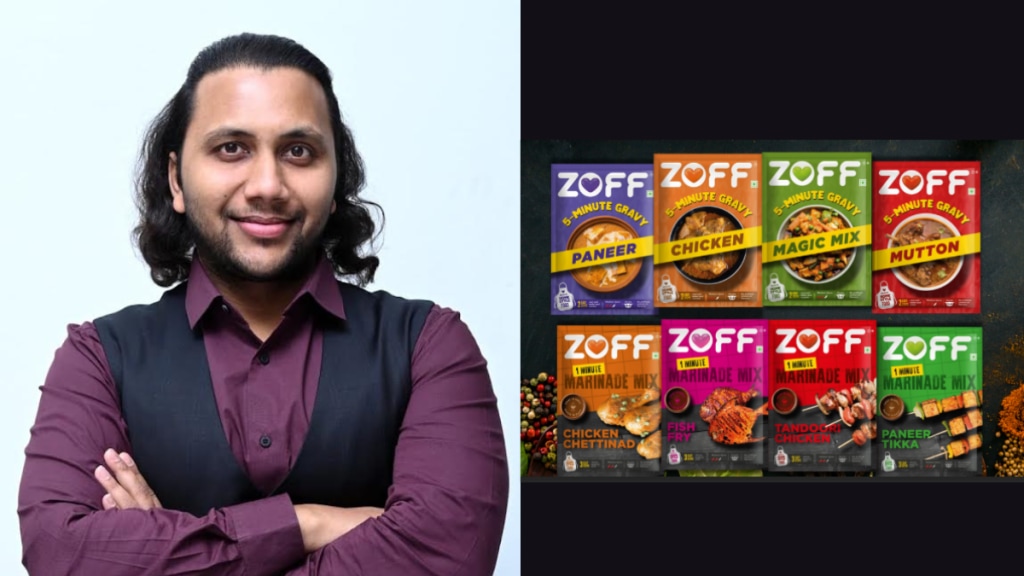‘Jaldi bano, lekin ghar jaisa lage’ – that’s what people really want.
That’s the space ZOFF Foods is eyeing as it swerves from masala jars to marinade pouches—ready-to-cook (RTC), minus the synthetic aftertaste. A Rs 150 packet. Four plates. No chopping, no preservatives. Just spice-forward mixes and marinades. The pitch? Homestyle, but faster.
So why is a Raipur-based spice company suddenly flirting with convenience food?
Because category expansion, when done right, is cheaper than CAC.
From masalas to meal kits- sort of
Akash Agrawalla, co-founder of ZOFF, told BrandWagon Online that he isn’t trying to compete with frozen parathas or microwaveable biryanis. His aim is sharper: to slot ZOFF into daily meal prep. Think of it as putting the “middle layer” back in the cooking journey. The brand’s 5-minute gravies and 1-minute marinades don’t come with ready-made paneer or pre-cooked rice. You still need fresh paneer or chicken. But you skip the onions, tomatoes, and a dozen spices.
Smart? Yes. Risky? Also yes.
Because here’s the thing: RTC in India is still an “oops-I-didn’t-cook” category, not a lifestyle one. ITC, Tata Sampann, and even Nestlé have thrown time, money, and R&D into this zone. Most have ended up with shelf presence, not shelf movement.
So what makes ZOFF think it’ll stick?
Agrawalla argues it’s about familiarity. “The gravies are built on spices—our core strength. No preservatives, no perishable ingredients. It’s not a meal replacement. It’s a kitchen shortcut.”
It’s a clean hook. But hooks need volume to hold.
Why this matters for retail—and competitors
The RTC pivot isn’t just a product story. It’s a channel strategy.
ZOFF’s legacy is digital-first. Roughly 80% of its revenue comes from online—Flipkart, Amazon, Blinkit, its own site. But now, it’s stepping into Reliance Retail’s vast offline jungle. The launch targets Tier 1 and Tier 2 metros. ZOFF says it plans to be in 400+ Reliance stores by mid-2025.
That’s a distribution leap, not a small experiment.
And for a brand that scaled to Rs 93 crore in FY24 (from Rs 25 crore four years ago), the Reliance tie-up feels like a distribution play as much as a category test. It’s what most legacy spice brands didn’t do early enough: go omnichannel before they were forced to.
But what’s the endgame here? Become the “Maggi of marination”? Or a full-stack kitchen solutions brand?
Time (and repeat purchase rates) will tell.
Okay, but will India buy into RTC 2.0?
Let’s not sugarcoat it—Indians like control in their kitchens. RTC often feels like a compromise. A cheat day. Not the default.
ZOFF’s bet is that the new urban cook isn’t looking for frozen food; they’re looking for time leverage. Add fresh paneer or fish to a flavour bomb base, and you’ve got a meal that feels earned, not assembled.
That’s a nuanced shift—and ZOFF might be early enough to claim that positioning.
The products—priced between Rs 75 and Rs 150—aim at 20–25-year-olds, living solo, working long hours, not keen on meal kits that taste like hostel dinners. One pouch, four servings. Easy math for nuclear households.
Still, the risk is taste. Shortcut cooking often backfires when the flavour flatlines. And in a price-sensitive market like India, anything above Rs 100 that doesn’t blow minds rarely sees a second order.
So, is this the future of Indian kitchens?
Maybe not in its current form. But ZOFF’s move feels more signal than stunt.
The company’s bootstrapped-to-funded arc has been steady. Over 2 million customers. 150+ SKUs. It even scored a Rs 40 crore Series A from JM Financial this year, with a clear mandate: expand retail reach, deepen product stack, and own the kitchen moment.
This RTC push is more than just spicy gravy—it’s a brand architecture experiment.
If it works, ZOFF won’t just be a spice company anymore. It’ll be the brand that codified convenience for the next generation of Indian cooks—without going fully synthetic.
And if it doesn’t? Well, at least they didn’t bet on premixed khichdi.
